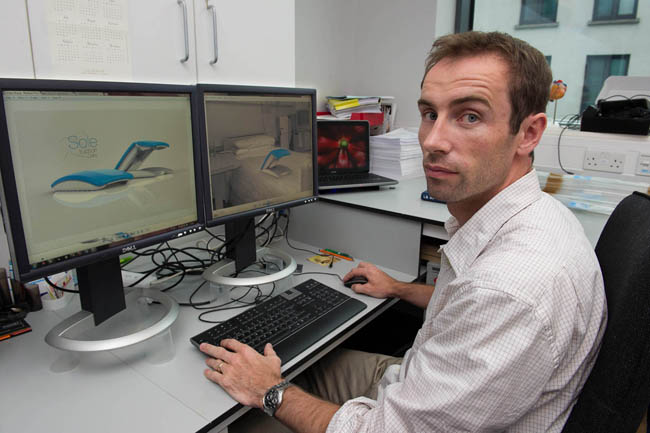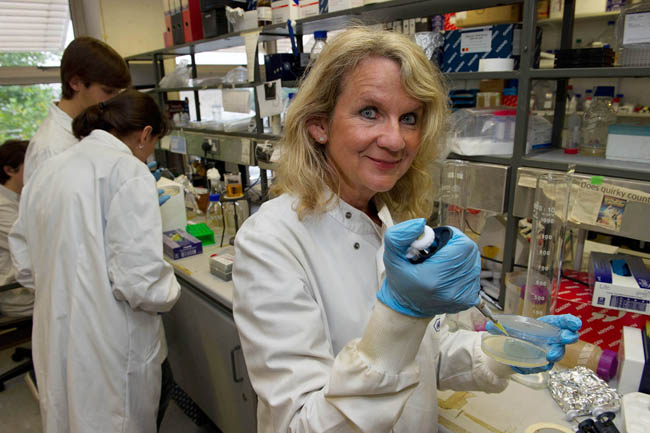Prof Jonathan Coleman (right) and post-grad Conor Boland (left) show Diarmuid O'Brien, Trinity Research and Innovation, how they are using graphene and plastic elastomers to create a wearable sensor. Image via Maura Hickey
Science Gallery in Dublin transformed into an ‘innovation lab’ for Trinity College Dublin (TCD) researchers to showcase some 36 innovations to investors yesterday. The researchers also aimed to attract venture capital (VC) attention and reel in funding to take their ideas to the next level, in order to create spin-out companies that can fill a commercial need and, ultimately, spawn home-grown sci-tech jobs.
A wearable sensor that will monitor health in real-time was just one of the newly invented technologies presented to investors at Science Gallery, which is based at the edge of the TCD campus. Nanoscience institute CRANN is also housed in the same building.
Prof Jonathan Coleman, who is based at CRANN, is the brain behind the device, along with post-grad student Conor Boland, who is based at the AMBER centre at TCD. The later centre is funded by Science Foundation Ireland (SFI), whose director-general Prof Mark Ferguson will be a panellist at the Innovation Ireland Forum in Dublin on Friday, 11 October.
Coleman and Boland invented this new type of health-tech sensor so it could be used to help people with health conditions recover and rehabilitate faster.
The sensor, which the researchers are describing as being “cheap and competitive”, is being developed so hospitals can use it. And not only that, the sensor also has the scope for uses in the fitness industry – think gyms – or as part of clothing for all consumers, ranging from the health conscious to dedicated followers of fashion.
The device can apparently measure with “extreme sensitivity” major vital signs, such as heart and breathing rate, high-strain muscular and joint motion, as well as vocalisation, Coleman and Boland said.
Its unique flexibility can seemingly detect small- and large-scale motions.
This has all been made possible via the use of the material graphene along with a plastic elastomer. In nanotech circles, graphene is often described as a ‘wonder material’.
Indeed, Coleman is part of a research consortia spanning Europe that has gleaned funding in order to pursue research around graphene that can have commercial applications for industry – and ultimately the consumer, around everything from beauty products, to clothing and food.

Dr Liam Breen, researcher at Trinity College Dublin
Other research on show yesterday was a medical device that has been co-invented by TCD researcher Dr Liam Breen. The goal here is to make leg ulcers heal faster via a special type of bandage.
And Prof Jane Farrar was on hand to talk about her gene replacement technology that she is pioneering to tackle retinal degenerative disease that has – so far – been untreatable.
Other research on display was yeasts that are being developed in order to enable new biofuels, plus security technology to allow safe storage of documents in the cloud and thus help prevent cybercrime.
“Trinity has a long history of successful commercialisation,” said Diarmuid O’Brien, executive director of Trinity Research and Innovation at the event.
He touched on spin-outs from the university, including the biomedical company Opsona Therapeutics, which this week clinched an extra €10m as part of its Series D €36m funding round. He also mentioned the games-industry software company Havok, which was sold to Intel for €76m.
O’Brien described the event as being an “excellent opportunity” to see the technologies that will drive the next generation of Trinity start-ups, in order to grow new jobs and target global exports markets.

Gene-replacement therapy is pioneered at Trinity College Dublin
Trinity provost Dr Patrick Prendergast said the showcase was a reflection of the meeting point of “research and real-world application”.
“Trinity has a strong tradition of innovation, and our research community is partnering with industry to create the new breakthrough technologies that could transform society.
“The focus on entrepreneurship which Trinity is developing is aimed at enabling Ireland’s innovation society and the creation of high-quality jobs that will last,” said Prendergast, who is an engineer by trade.
In the past two years, eight Trinity spin-outs or licensees have attracted almost €58m in VC funding, according to the university.
At the Innovation Ireland Forum in Dublin on 11 October, leaders and stakeholders will discuss Ireland as the go-to destination for knowledge that will drive the next economy